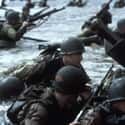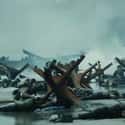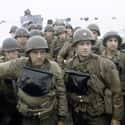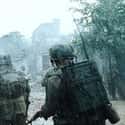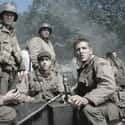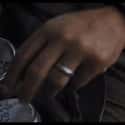-
(#1) Heavy Equipment Made It Incredibly Hard For The Landing Forces To Get Solid Footing
The struggle to get to shore on D-Day was multifaceted. Heavy gear, equipment, and supplies weighed soldiers down, while constant artillery fire threatened every move. As 20-year-old Ted Cordery watched on, he saw several soldiers never even get to the beaches of Normandy, succumbing to the English Channel instead.
Saving Private Ryan accurately shows troops let off into water that was too deep for them to touch the ground. Cordery recalled decades later:
I felt so sorry for the men. They were coming from a fair way out to get to the beach, and they were all in their uniforms and carrying guns and their own food, so they all had these cans weighing them down... So many of them didn't make it because they were dropped too far from the land. They went straight in the deep water and drowned.
-
(#2) Only Sounds From Authentic WWII Weapons Were Used
To add to the realistic feel that sets Saving Private Ryan apart from other war movies, sound effects engineers sought out WWII weapons and vehicles in order to record and incorporate them into the film.
Sound designer Gary Rydstrom hoped to recreate the sounds of WWII, having been told by Steven Spielberg that he "didn't want cliches... there might be a lot of cheating in sound effects from the classic war movies," and there was to be none of that "cheating" in this film.
In addition to gunfire from WWII machine guns and rifles, the sound of bullets underwater accompanied the representation of temporary hearing impairment caused by the overwhelming noise of battle.
-
(#3) The Anti-Seacraft 'Czech Hedgehogs' In The Water At Normandy Reflect One Of The Miscalculations Made By The Germans
The presence and placement of Czech hedgehogs at Normandy - crossed bars of iron or steel welded into spiky obstacles - gives insight into preparations for the invasion by the Germans. Often used to disable tanks, the Czech hedgehogs were an ideal defense against landing vessels, as well. When underwater, approaching boats and ships would be struck.
Germany believed the invasion of Normandy by Allied Forces was going to take place at high tide. The Allied Navy and Army, however, opted to begin their approach in the early morning hours of June 6, 1944, when the tide was low. This gave them time to disable some of the underwater defenses installed by the Germans.
-
(#4) Director Spielberg Insisted On Casting Real-Life Amputees - With One Clear Exception
Instead of filming the movie and later removing limbs or adding other injuries via computer effects, Steven Spielberg opted to incorporate real-life amputees into his cast.
According to associate producer Mark Huffam:
We had somewhere between 20 and 30 amputees and paraplegics who worked with us, creating very realistic scenes where we could use effects to make it look like soldiers were losing limbs. Some might say it was an insensitive approach, but they all did it with great enthusiasm.
Not only did this add to the film's realism, but it also mitigated post-production costs.
One actor who appeared as an amputee - but notably wasn't - however, was Bryan Cranston.
-
(#5) The Soldiers In The Movie Wore Unfastened Helmets
Throughout Saving Private Ryan, soldiers are shown wearing helmets with chinstraps either hanging by the sides of their heads or fastened in the back. During WWII, it was common for men to leave their M1 helmets - made of an outer steel shell and an inner liner - unfastened due to concern among soldiers that a chinstrap would be dangerous in an explosion. The fear was that the force from the blast would blow one's helmet back, breaking the wearer's neck in the process.
It was reported that General George S. Patton even ordered men to leave their helmets unfastened after one of his aides perished in Tunisia in this exact manner.
-
(#6) Soldiers Did Throw Mortar Shells During WWII
In one scene in Saving Private Ryan, Matt Damon throws a mortar shell, an action that actually led to many individuals who watched the movie crying foul. According to naysayers, no soldier would have ever thrown such a dangerous piece of ammunition.
There are accounts of soldiers doing just that, however. Technical Sergeant Beauford T. Anderson received a Congressional Medal of Honor for his service during WWII, with a citation that read in part:
He seized an enemy mortar dud and threw it back among the charging [Japanese], killing several as it burst. Securing a box of mortar shells, he extracted the safety pins, banged the bases upon a rock to arm them and proceeded alternately to hurl shells and fire his piece among the fanatical foe, finally forcing them to withdraw.
Chuck "Commando" E. Kelly also earned a Congressional Medal of Honor, having "picked up 60-mm mortar shells, pulled the safety pins, and used the shells as grenades, killing at least five of the enemy" while serving in Italy in 1943.
-
(#7) Soldiers Did Get Seasick Crossing The English Channel
For director Steven Spielberg, it was important to capture the complexities of the conditions on D-Day:
It was a blustery day at 6:30 a.m. in the Dog Green sector of Omaha Beach, and the English Channel was a maelstrom. It was all waves and seasickness and waiting for the landing to begin. I wanted this shot to simply symbolize the calmest moment you’d get in the entire experience of watching this film.
The fear seen in the faces of the soldiers as they are transported to the beaches of Normandy in Saving Private Ryan emphasizes the emotions felt by those men as they went into combat. Additionally, bouts of seasickness brought to life the physical reactions to both the choppy waters of the English Channel and the palpable terror in the moments before battle.
The honest portrayal of seasickness resonated with veterans like Ted Cordery and Harold Baumgarten. Cordery recalled seeing how "bouncing" boats caused seasickness among troops as they approached the beaches of Northern France. For his part, Baumgarten staved off getting sick during his transport across the English Channel by skipping breakfast on the morning of the invasion.
-
(#8) They Opted For Very Subtle Military Jargon
In many war movies, the language used among soldiers is altered for the audience. For example, Captain Miller (Tom Hanks) calls "CATF" into the radio several times, which is short for "Commander, Amphibious Task Force." The audience may not know the meaning of the acronym, but it is authentic military terminology and reflects actual communication that would have taken place between men in the field and the individual in charge of an amphibious operation.
As another example, it's common to say someone was killed in combat, a civilian expression that's found its way into movies and television. Terminology like KIA is more appropriate among soldiers, and that's what one hears in Saving Private Ryan.
According to Dale Dye, a military consultant on Saving Private Ryan, "That's how real soldiers talk... and the audience gets it." Steven Spielberg wanted to embrace straightforward military speak, really enjoying terms like "defilade," which, according to Dye, "refers to the angle of the weapon and its beaten zone." Essentially, the "defilade" position is an area within which you can't get hit by someone firing at you.
-
(#9) There's A Scene Where Reich Soldiers Speak Czech Instead Of German
In one scene of Saving Private Ryan, Reich soldiers attempt to surrender to Allied Forces amid the chaos at Omaha Beach. The two men plead for their lives but, significantly, they don't do so in German. Rather, they use their native tongue, Czech - crying out, "Please don’t shoot me! I am not German, I am Czech, I didn’t kill anyone! I am Czech!"
In 1939, Adolf Hitler threatened the president of Czechoslovakia, Emil Hacha, with a bombing attack on Prague. In order to avoid the destruction of the city, Hacha had to give Hitler entry into the country - which he granted in March. As German forces pushed through Czechoslovakia in the early years of WWII, they seized land and conscripted men into service.
The soldiers in Saving Private Ryan represent a small subset of individuals from lands absorbed into the Third Reich. Men became either the Volkdeutsche (forces considered to be "racial Germans"), or the Ost-Bataillone (Eastern forces from various ethnic backgrounds, such as Cossack, Ukrainian, Georgian, or Russian).
-
(#10) Matt Damon Was Kept Separate From The Rest Of The Cast To Create Real Onscreen Animosity
The cast of Saving Private Ryan went to boot camp in anticipation of the movie, a grueling 10-day training program overseen by military consultant and former Marine Dale Dye. Boot camp meant long marches, little sleep, and harsh conditions - all of which made Tom Hanks want to quit after four days.
Matt Damon, however, was exempt from the boot camp, a deliberate choice by director Steven Spielberg. Since Damon was portraying Private Ryan - the individual at the heart of the mission undertaken by Hanks's character and others - he was set apart from the rest of the group. This fostered animosity and resentment with his cast members that could be captured onscreen as the tension that would necessarily exist between Ryan and the soldiers sacrificing themselves for a lone brother-in-arms.
For his part, Damon did take part in separate training exercises.
-
(#11) Spielberg Attached Drills To The Cameras To Simulate The Shaking And Disruption Of Explosions
Steven Spielberg thought he was onto something when he attached drills to his camera to make it shake, testing "a Black & Decker drill taped to a Panaflex camera so the image would vibrate whenever I turned on the drill."
The goal was to recreate the impact of an explosion and, according to key grip Jim Kwiatkowski, it worked:
...the best boy, Bob Anderson, attached an electric drill to the pan handle of a fluid head and locked an oblong bolt with an eccentric washer in the chuck. When activated, it created a wobbling movement and the camera shake we wanted.
In the end, cinematographer Janusz Kaminski realized, "It's a great effect, but you certainly can't handhold the camera with a drill attached to it. Plus, your eye is constantly bopping against the viewfinder." He and Spielberg opted for a lens that created the same effect, "only without having someone with a 90-yard extension cord running behind the camera."
-
(#12) Soldiers Often Collected Dirt As A Symbol Of Where They'd Served
Tom Sizemore's character, Sergeant Horvath, is seen gathering soil from France and placing it in a tin. When he puts the small container in his bag, there's a glimpse of similar tins labeled Italy and Africa, indicating he's collected dirt and sand from those locations, as well.
What Horvath does in Saving Private Ryan was common for WWII soldiers. Many men who served took home souvenirs. Talismans like soil, seashells, and rocks taken from the places they served functioned as a special reminder of survival. Such items could also become a source of good luck.
When Frank Gagliano, a member of the 101st Airborne who stormed Omaha Beach on D-Day, revisited Normandy decades after the invasion, he actually grabbed some sand to take home with him. Gagliano noted, "I didn't think to do it the first time... I was too busy trying to stay alive."
New Random Displays Display All By Ranking
About This Tool
Our data comes from Ranker, If you want to participate in the ranking of items displayed on this page, please click here.

